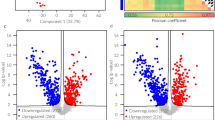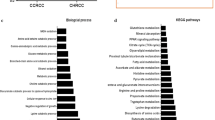Abstract
Renal cell carcinoma (RCC) is one of the most common malignancies in adults, and there is still no acknowledged biomarker for its diagnosis, prognosis, recurrence monitoring, and treatment stratification. Besides, little is known about the post-translational modification (PTM) of proteins in RCC. Here, we performed quantitative proteomic analysis on 12 matched pairs of clear cell RCC (ccRCC) and adjacent kidney tissues using liquid chromatography-tandem mass spectrometry (nanoLCMS/MS) and Progenesis LC-MS software (label-free) to identify and quantify the dysregulated proteins. A total of 1872 and 1927 proteins were identified in ccRCC and adjacent kidney tissues, respectively. Among these proteins, 1037 proteins were quantified by Progenesis LC-MS, and 213 proteins were identified as dysregulated proteins between ccRCC and adjacent tissues. Pathway analysis using IPA, STRING, and David tools was performed, which demonstrated the enrichment of cancer-related signaling pathways and biological processes such as mitochondrial dysfunction, metabolic pathway, cell death, and acetylation. Dysregulation of two mitochondrial proteins, acetyl-CoA acetyltransferase 1 (ACAT1) and manganese superoxide dismutase (MnSOD) were selected and confirmed by Western blotting and immunohistochemistry assays using another 6 pairs of ccRCC and adjacent tissues. Further mass spectrometry analysis indicated that both ACAT1 and MnSOD had characterized acetylation at lysine residues, which is the first time to identify acetylation of ACAT1 and MnSOD in ccRCC. Collectively, these data revealed a number of dysregulated proteins and signaling pathways by label-free quantitative proteomic approach in RCC, which shed light on potential diagnostic or prognostic biomarkers and therapeutic molecular targets for clinical intervention of RCC.





Similar content being viewed by others
References
Rini BI, Campbell SC, Escudier B. Renal cell carcinoma. Lancet. 2009;373(9669):1119–32. doi:10.1016/S0140-6736(09)60229-4.
Craven RA, Stanley AJ, Hanrahan S, Dods J, Unwin R, Totty N, et al. Proteomic analysis of primary cell lines identifies protein changes present in renal cell carcinoma. Proteomics. 2006;6(9):2853–64. doi:10.1002/pmic.200500549.
Siegel R, Ma J, Zou Z, Jemal A. Cancer statistics, 2014. CA Cancer J Clin. 2014;64(1):9–29. doi:10.3322/caac.21208.
Atrih A, Mudaliar MA, Zakikhani P, Lamont DJ, Huang JT, Bray SE, et al. Quantitative proteomics in resected renal cancer tissue for biomarker discovery and profiling. Br J Cancer. 2014;110(6):1622–33. doi:10.1038/bjc.2014.24.
Gupta K, Miller JD, Li JZ, Russell MW, Charbonneau C. Epidemiologic and socioeconomic burden of metastatic renal cell carcinoma (mRCC): a literature review. Cancer Treat Rev. 2008;34(3):193–205. doi:10.1016/j.ctrv.2007.12.001.
Janech MG, Raymond JR, Arthur JM. Proteomics in renal research. Am J Physiol Ren Physiol. 2007;292(2):F501–12. doi:10.1152/ajprenal.00298.2006.
Ding S, Zhao Z, Sun D, Wu F, Bi D, Lu J, et al. Eg5 inhibitor, a novel potent targeted therapy, induces cell apoptosis in renal cell carcinoma. Tumour Biol J Int Soc Oncodev Biol Med. 2014;35(8):7659–68. doi:10.1007/s13277-014-2022-x.
Motzer RJ, Hutson TE, Cella D, Reeves J, Hawkins R, Guo J, et al. Pazopanib versus sunitinib in metastatic renal-cell carcinoma. N Engl J Med. 2013;369(8):722–31. doi:10.1056/NEJMoa1303989.
Aebersold R, Mann M. Mass spectrometry-based proteomics. Nature. 2003;422(6928):198–207. doi:10.1038/nature01511.
White NM, Masui O, Desouza LV, Krakovska O, Metias S, Romaschin AD, et al. Quantitative proteomic analysis reveals potential diagnostic markers and pathways involved in pathogenesis of renal cell carcinoma. Oncotarget. 2014;5(2):506–18.
Sangawa A, Shintani M, Yamao N, Kamoshida S. Phosphorylation status of Akt and caspase-9 in gastric and colorectal carcinomas. Int J Clin Exp Pathol. 2014;7(6):3312–7.
Wu YM, Liu CH, Huang MJ, Lai HS, Lee PH, Hu RH, et al. C1GALT1 enhances proliferation of hepatocellular carcinoma cells via modulating MET glycosylation and dimerization. Cancer Res. 2013;73(17):5580–90. doi:10.1158/0008-5472.CAN-13-0869.
Noh SJ, Kang MJ, Kim KM, Bae JS, Park HS, Moon WS, et al. Acetylation status of P53 and the expression of DBC1, SIRT1, and androgen receptor are associated with survival in clear cell renal cell carcinoma patients. Pathology. 2013;45(6):574–80. doi:10.1097/PAT.0b013e3283652c7a.
Chen Y, Zhang J, Lin Y, Lei Q, Guan KL, Zhao S, et al. Tumour suppressor SIRT3 deacetylates and activates manganese superoxide dismutase to scavenge ROS. EMBO Rep. 2011;12(6):534–41. doi:10.1038/embor.2011.65.
Wang Q, Zhang Y, Yang C, Xiong H, Lin Y, Yao J, et al. Acetylation of metabolic enzymes coordinates carbon source utilization and metabolic flux. Science. 2010;327(5968):1004–7. doi:10.1126/science.1179687.
Zhao S, Xu W, Jiang W, Yu W, Lin Y, Zhang T, et al. Regulation of cellular metabolism by protein lysine acetylation. Science. 2010;327(5968):1000–4. doi:10.1126/science.1179689.
Yi C, Ma M, Ran L, Zheng J, Tong J, Zhu J, et al. Function and molecular mechanism of acetylation in autophagy regulation. Science. 2012;336(6080):474–7. doi:10.1126/science.1216990.
Nagaprashantha LD, Talamantes T, Singhal J, Guo J, Vatsyayan R, Rauniyar N, et al. Proteomic analysis of signaling network regulation in renal cell carcinomas with differential hypoxia-inducible factor-2alpha expression. PLoS One. 2013;8(8):e71654. doi:10.1371/journal.pone.0071654.
Ramakrishnan S, Ellis L, Pili R. Histone modifications: implications in renal cell carcinoma. Epigenomics. 2013;5(4):453–62. doi:10.2217/epi.13.40.
Perroud B, Lee J, Valkova N, Dhirapong A, Lin PY, Fiehn O, et al. Pathway analysis of kidney cancer using proteomics and metabolic profiling. Mol Cancer. 2006;5:64. doi:10.1186/1476-4598-5-64.
Parviainen VI, Joenvaara S, Tohmola N, Renkonen R. Label-free mass spectrometry proteome quantification of human embryonic kidney cells following 24 h of sialic acid overproduction. Proteome Sci. 2013;11(1):38. doi:10.1186/1477-5956-11-38.
Edge SB, Compton CC. The American Joint Committee on Cancer: the 7th edition of the AJCC cancer staging manual and the future of TNM. Ann Surg Oncol. 2010;17(6):1471–4. doi:10.1245/s10434-010-0985-4.
Wu F, Zhao ZH, Ding ST, Wu HH, Lu JJ. High mobility group box 1 protein is methylated and transported to cytoplasm in clear cell renal cell carcinoma. Asian J Cancer Prev APJCP. 2013;14(10):5789–95.
Theron L, Gueugneau M, Coudy C, Viala D, Bijlsma A, Butler-Browne G, et al. Label-free quantitative protein profiling of vastus lateralis muscle during human aging. Mol Cell Proteomics MCP. 2014;13(1):283–94. doi:10.1074/mcp.M113.032698.
Szklarczyk D, Franceschini A, Kuhn M, Simonovic M, Roth A, Minguez P, et al. The STRING database in 2011: functional interaction networks of proteins, globally integrated and scored. Nucleic Acids Res. 2011;39(Database issue):D561–8. doi:10.1093/nar/gkq973.
Saraon P, Cretu D, Musrap N, Karagiannis GS, Batruch I, Drabovich AP, et al. Quantitative proteomics reveals that enzymes of the ketogenic pathway are associated with prostate cancer progression. Molecular & cellular proteomics : MCP. 2013;12(6):1589–601. doi:10.1074/mcp.M112.023887.
Chu SH, Liu YW, Zhang L, Liu B, Li L, Shi JZ, et al. Regulation of survival and chemoresistance by HSP90AA1 in ovarian cancer SKOV3 cells. Mol Biol Rep. 2013;40(1):1–6. doi:10.1007/s11033-012-1930-3.
Lebdai S, Verhoest G, Parikh H, Jacquet SF, Bensalah K, Chautard D, et al. Identification and validation of TGFBI as a promising prognosis marker of clear cell renal cell carcinoma. Urol Oncol. 2014. doi:10.1016/j.urolonc.2014.06.005.
Arner E, Forrest AR, Ehrlund A, Mejhert N, Itoh M, Kawaji H, et al. Ceruloplasmin is a novel adipokine which is overexpressed in adipose tissue of obese subjects and in obesity-associated cancer cells. PLoS One. 2014;9(3):e80274. doi:10.1371/journal.pone.0080274.
Saraon P, Trudel D, Kron K, Dmitromanolakis A, Trachtenberg J, Bapat B, et al. Evaluation and prognostic significance of ACAT1 as a marker of prostate cancer progression. Prostate. 2014;74(4):372–80. doi:10.1002/pros.22758.
Dhar SK, St Clair DK. Manganese superoxide dismutase regulation and cancer. Free Radic Biol Med. 2012;52(11–12):2209–22. doi:10.1016/j.freeradbiomed.2012.03.009.
Kim HS, Patel K, Muldoon-Jacobs K, Bisht KS, Aykin-Burns N, Pennington JD, et al. SIRT3 is a mitochondria-localized tumor suppressor required for maintenance of mitochondrial integrity and metabolism during stress. Cancer Cell. 2010;17(1):41–52. doi:10.1016/j.ccr.2009.11.023.
Haapalainen AM, Merilainen G, Pirila PL, Kondo N, Fukao T, Wierenga RK. Crystallographic and kinetic studies of human mitochondrial acetoacetyl-CoA thiolase: the importance of potassium and chloride ions for its structure and function. Biochemistry. 2007;46(14):4305–21. doi:10.1021/bi6026192.
Fan J, Shan C, Kang HB, Elf S, Xie J, Tucker M, et al. Tyr phosphorylation of PDP1 toggles recruitment between ACAT1 and SIRT3 to regulate the pyruvate dehydrogenase complex. Mol Cell. 2014;53(4):534–48. doi:10.1016/j.molcel.2013.12.026.
Weydert CJ, Waugh TA, Ritchie JM, Iyer KS, Smith JL, Li L, et al. Overexpression of manganese or copper-zinc superoxide dismutase inhibits breast cancer growth. Free Radic Biol Med. 2006;41(2):226–37. doi:10.1016/j.freeradbiomed.2006.03.015.
Dhar SK, Tangpong J, Chaiswing L, Oberley TD, St Clair DK. Manganese superoxide dismutase is a p53-regulated gene that switches cancers between early and advanced stages. Cancer Res. 2011;71(21):6684–95. doi:10.1158/0008-5472.CAN-11-1233.
Quiros I, Sainz RM, Hevia D, Garcia-Suarez O, Astudillo A, Rivas M, et al. Upregulation of manganese superoxide dismutase (SOD2) is a common pathway for neuroendocrine differentiation in prostate cancer cells. International Journal of Cancer Journal International du Cancer. 2009;125(7):1497–504. doi:10.1002/ijc.24501.
Perry JJ, Hearn AS, Cabelli DE, Nick HS, Tainer JA, Silverman DN. Contribution of human manganese superoxide dismutase tyrosine 34 to structure and catalysis. Biochemistry. 2009;48(15):3417–24. doi:10.1021/bi8023288.
Qiu X, Brown K, Hirschey MD, Verdin E, Chen D. Calorie restriction reduces oxidative stress by SIRT3-mediated SOD2 activation. Cell Metab. 2010;12(6):662–7. doi:10.1016/j.cmet.2010.11.015.
Huang P, Feng L, Oldham EA, Keating MJ, Plunkett W. Superoxide dismutase as a target for the selective killing of cancer cells. Nature. 2000;407(6802):390–5. doi:10.1038/35030140.
Carew JS, Huang P. Mitochondrial defects in cancer. Mol Cancer. 2002;1:9.
Mitrakas AG, Kalamida D, Koukourakis MI. Effect of mitochondrial metabolism-interfering agents on cancer cell mitochondrial function and radio/chemosensitivity. Anti-Cancer Drugs. 2014. doi:10.1097/CAD.0000000000000152.
Wang Y, Zhang R, Wu D, Lu Z, Sun W, Cai Y, et al. Epigenetic change in kidney tumor: downregulation of histone acetyltransferase MYST1 in human renal cell carcinoma. Journal of experimental & clinical cancer research : CR. 2013;32:8. doi:10.1186/1756-9966-32-8.
Juengel E, Dauselt A, Makarevic J, Wiesner C, Tsaur I, Bartsch G, et al. Acetylation of histone H3 prevents resistance development caused by chronic mTOR inhibition in renal cell carcinoma cells. Cancer Lett. 2012;324(1):83–90. doi:10.1016/j.canlet.2012.05.003.
Kanao K, Mikami S, Mizuno R, Shinojima T, Murai M, Oya M. Decreased acetylation of histone H3 in renal cell carcinoma: a potential target of histone deacetylase inhibitors. J Urol. 2008;180(3):1131–6. doi:10.1016/j.juro.2008.04.136.
Acknowledgments
This study was supported in part by the grants from the National Natural Science Foundation of China (No. 81202017) and the Natural Science Foundation Shandong Province (No. ZR2011HQ027).
Conflicts of interest
None.
Ethics statement
All procedures were consistent with the National Institutes of Health Guide and approved by the institutional board with patients’ written consent. This study was evaluated and approved by the Ethics Committee of Shandong Provincial Hospital Affiliated to Shandong University.
Author information
Authors and Affiliations
Corresponding author
Electronic supplementary material
Below is the link to the electronic supplementary material.
Online resource 1
(XLS 3573 kb)
Online resource 2
(XLS 545 kb)
Online resource 3
(XLS 127 kb)
Rights and permissions
About this article
Cite this article
Zhao, Z., Wu, F., Ding, S. et al. Label-free quantitative proteomic analysis reveals potential biomarkers and pathways in renal cell carcinoma. Tumor Biol. 36, 939–951 (2015). https://doi.org/10.1007/s13277-014-2694-2
Received:
Accepted:
Published:
Issue Date:
DOI: https://doi.org/10.1007/s13277-014-2694-2




